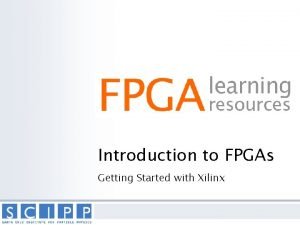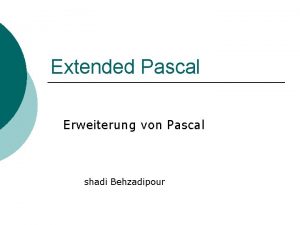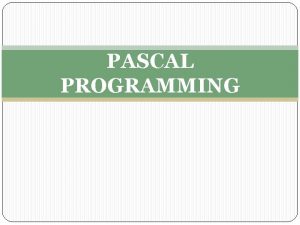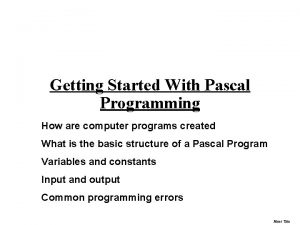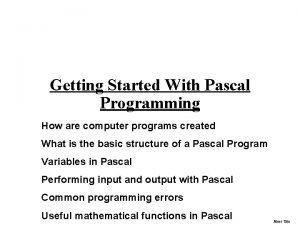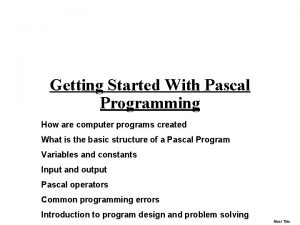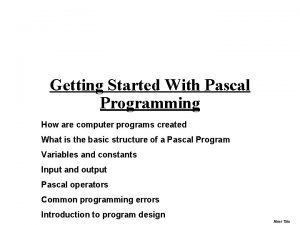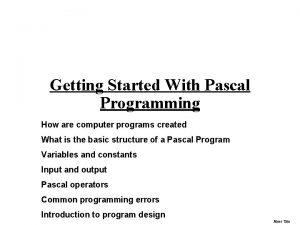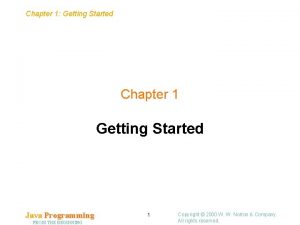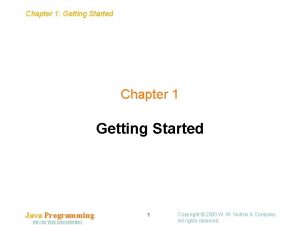Getting Started With Pascal Programming What is the



















- Slides: 19

Getting Started With Pascal Programming What is the basic structure of a Pascal Program Variables in Pascal Performing input and output with Pascal Useful mathematical functions in Pascal James Tam

Basic Structure Of Pascal Programs (* Header *) program name (input, output) declarations var const begin end. James Tam

Variables Set aside a location in memory Used to store information (temporary) Types: • integer – whole numbers • real – whole numbers and fractions - Can't end or start with a decimal • char – alphabetic, numeric and miscellaneous symbols • boolean – true or false values Usage: • Declaration • Using values stored James Tam

Declaring Variables Sets aside memory Memory locations addressed through the name Naming conventions • Should be meaningful • Any combination of letters, numbers or underscore (can't begin with a number and shouldn't begin with an underscore) • Can't be a reserved word e. g. , program, begin, end (see Appendix B) • Avoid using words with an existing meaning e. g. , integer, real, boolean, writeln, readln • Avoid distinguishing variable names only by case • Okay: - tax_rate - first. Name • Not Okay - 1 abc x test. msg good-day James Tam

Declaring Variables (2) Typically occurs in the variable declaration ("var") section i. e. , var name of first variable, name of second variable…: type of variables; e. g. , var height, weight: real; age: integer; James Tam

Using Values Stored In Variables Assignment • Performed via the assignment operator : = • Usage: - Destination : = Source; 1 • Example: - x : = 5; x: = y; interest : = principle * rate; Initial : = 'j'; • Avoid assigning mixed types e. g. , var num 1: integer; num 2: real; Begin num 1 = 12; num 2 = 12. 5; num 2 : = num 1; Not allowed! num 1 : = num 2; 1 The source can be any expression (constant, variable or formula) James Tam

Named Constants A memory location that is assigned a value that cannot be changed Format: const name of first constant = value of first constant; name of second constant = value of second constant; etc. Location Anywhere after the "program" statement and before the "begin" James Tam

Purpose of Named Constants 1) Makes the program easier to understand e. g. , begin population_change : = (0. 1758 – 0. 1257) * current_population; Vs. const BIRTHRATE = 0. 1758; Magic Numbers (avoid!) DEATHRATE = 0. 1257; begin population_change : = (BIRTHRATE - DEATHRATE) * current_population; 2) Makes the program easier to maintain James Tam

Output Displaying information onscreen Done via the write and writeln statements Formats (either write or writeln): write ('text message'); or writeln('text message'); write(name of variable or constant); or writeln (name of variable or constant); write('message', name of variable, 'message'…); or writeln('message', name of variable, 'message'…); James Tam

Formatting Output Computer often inserts spaces as it thinks is necessary in order to display output. Manually formatting of output: • write or writeln (data to output: field width for data: no. of decimal places) • e. g. , writeln (num 1: 6: 2); If the field width doesn’t match the actual size of the field • Field width too small – extra spaces will be added for numerical variables. • Field width too large – the data will be right justified (extra spaces will be put in front of the data). James Tam

Formatting Output (2) If the number of decimal places doesn’t match the actual number of decimal places. • Set number of decimal places less than the actual number of decimal places – number will be rounded up. • Set number of decimal places greater than the actual number of decimal places – number will be padded with zeros. James Tam

Formatting Output: Examples For the complete program and executable look under /home/231/examples/getting_started/out 1. p (out 1 for the compiled version) num 1 : = 123; num 2 : = 123. 456; writeln('Auto formatted by Pascal ', num 1, num 2); writeln('Manual format': 13, num 1: 3, num 2: 7: 3); writeln('Manual not enough': 13, num 1: 2, num 2: 6: 3); writeln('Manual too much': 16, num 1: 4, num 2: 8: 4); James Tam

Input The computer program getting information from the user Done via the read and readln statements Formats: (single input) read (name of variable); or readln (name of variable); (multiple inputs) read (nv 1, nv 2…); or readln (nv 2, nv 3…); James Tam

Input: Read Vs. Readln Both: • Reads each value inputted and matches it the corresponding variable. Read • If the user inputs additional values they will remain Readln • Any additional values inputted will be discarded James Tam

Input: Read Vs. Readln (An example) For the complete version of this program look in Unix under: /home/231/examples/getting_started/read 1. p (or read 1 and read 2 for the compiled version) e. g. , read 1. p write('Input some integers making sure to separate each one with a space '); write('or a new line: '); read (num 1, num 2); write('Input some integers making sure to separate each one with a space '); write('or a newline: '); read(num 3, num 4); James Tam

Input: Read Vs. Readln (An example (2)) For the complete version of this program look in Unix under: /home/231/examples/getting_started/read 2. p (or read 2 for the compiled version) e. g. , read 2. p write('Input some integers making sure to separate each one with a space '); write('or a newline: '); readln (num 1, num 2); write('Input some integers making sure to separate each one with a space '); write('or a newline: '); readln(num 3, num 4); James Tam

Uses Of Readln To filter out extraneous input As an input prompt e. g. , writeln('To continue press return'); readln; James Tam

Some Useful Functions See also Appendix D in Pascal Programming and Problem Solving by Leestma S. and Nyhoff L. Name Description Input type Type of result Example absolute value integer real abs(-2) = 2 abs(-2. 2) = 2. 2 rounding real integer round(2. 6) = 3 truncation real integer trunc(2. 6) = 2 sqr squaring integer real sqr(2) = 4 sqr(1. 1) = 1. 21 sqrt square root integer real sqrt(4) = 2. 00 or real James Tam

Summary What are the fundamental parts of a Pascal program What are the basic types of variables employed in Pascal and how are they used How to output information with the write and writeln statements Getting information from the user through the read and readln statements How are some common mathematical functions performed in Pascal James Tam
 The secret to getting ahead is getting started
The secret to getting ahead is getting started When does elena receive dolls from her family members
When does elena receive dolls from her family members Getting started with unix
Getting started with unix Getting started with eclipse
Getting started with eclipse Getting started with vivado
Getting started with vivado Outlook tutorial 2010
Outlook tutorial 2010 Getting started with poll everywhere
Getting started with poll everywhere Unit 1 getting started
Unit 1 getting started Education splunk
Education splunk Hakan kutucu
Hakan kutucu Getting started with ft8
Getting started with ft8 Perl read_file
Perl read_file Counter code
Counter code Android development getting started
Android development getting started Find these things in unit 1
Find these things in unit 1 Rancher slack channel
Rancher slack channel Listen and read unit 3
Listen and read unit 3 Getting started with lua
Getting started with lua Tipos de habilidades del pensamiento
Tipos de habilidades del pensamiento Getting started with vivado
Getting started with vivado












